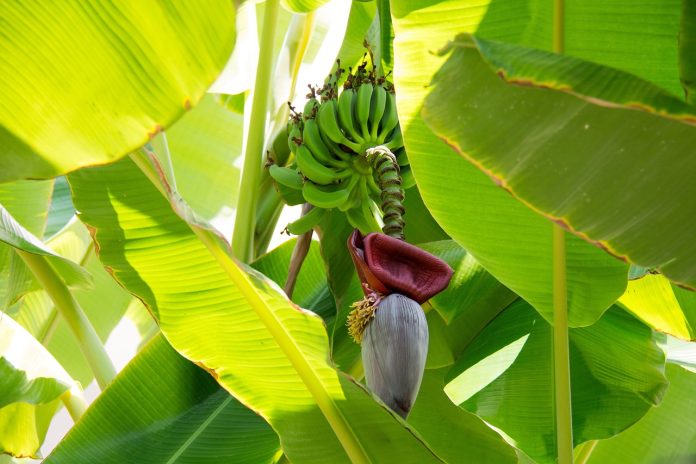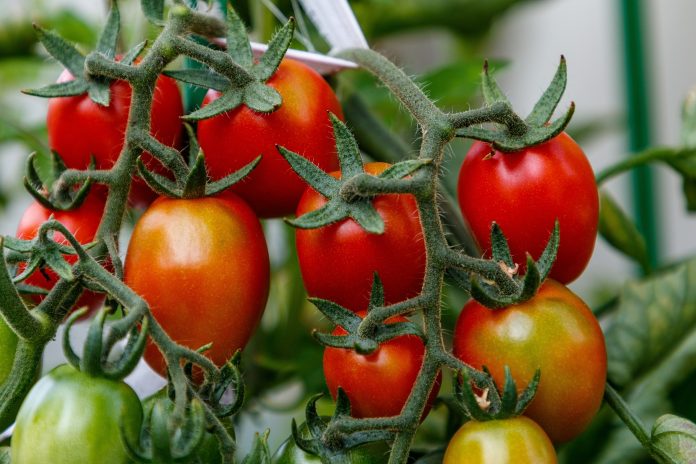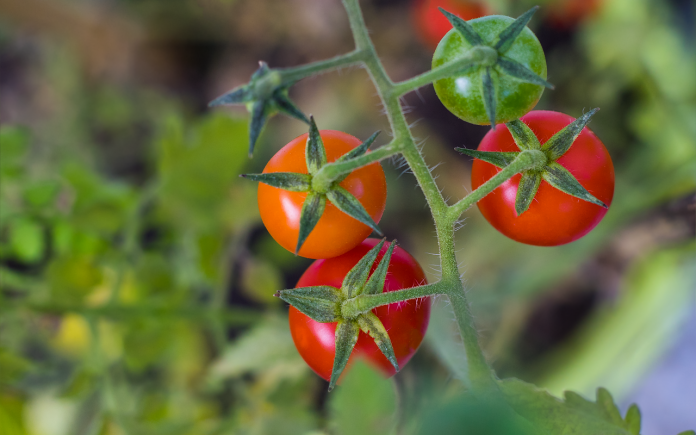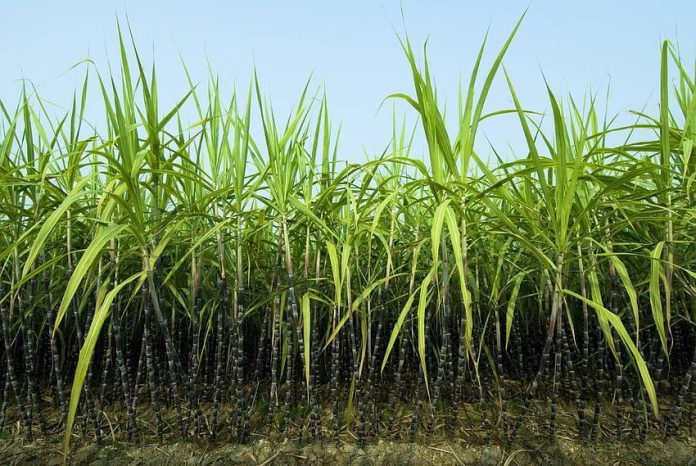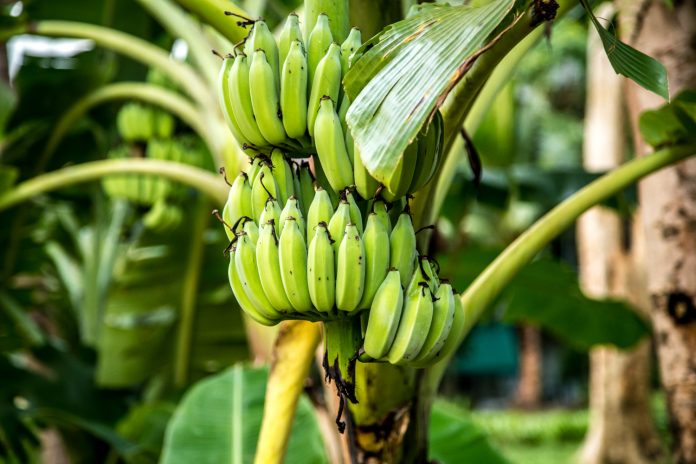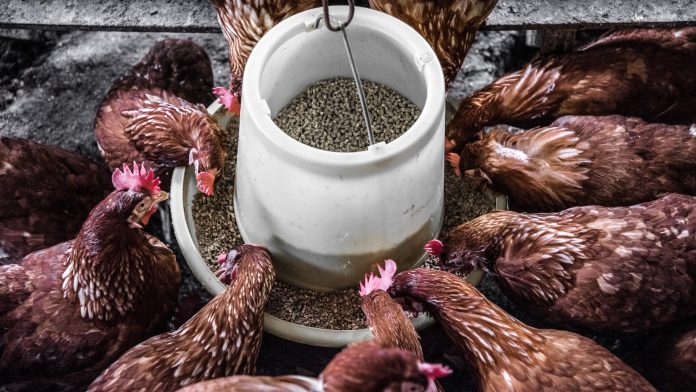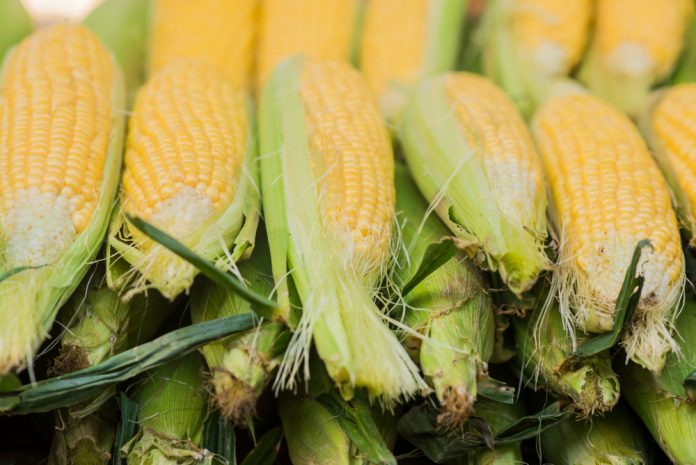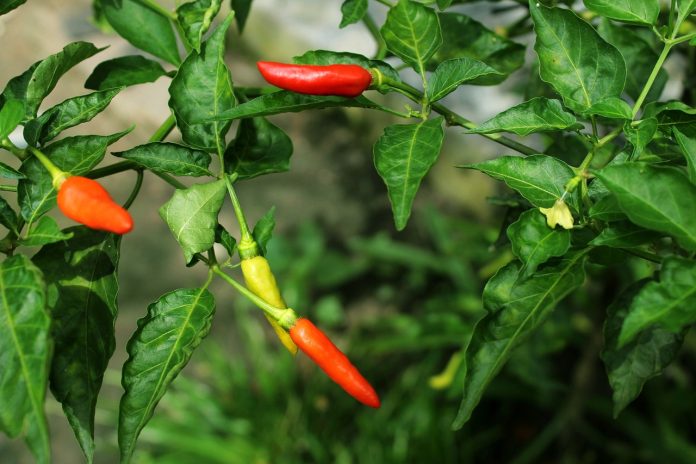Banana is a major fruit crop that is grown for commercial purposes in many countries around the world. It is a staple food and a dessert in some parts of the world. It is also a key source of foreign income for many African countries that export it. However, most of the commercial varieties of banana are very susceptible to various fatal diseases. These diseases are caused by fungi, bacteria, and viruses that limit the quality and yield of the crop. Moreover, the pathogens quickly become resistant to new pesticides, making the disease control more challenging. Therefore, organic inputs are a better alternative to deal with this problem.
List of Diseases
- Sigatoka Leaf Spot
- Fusarium wilt
- Bacterial wilt
- Bunchy top virus
1. Sigatoka Leaf Spot
Scientific name: Mycospharellamusicola
Most Affected Plant Part: Stem and Leaves
Symptoms of Sigatoka Leaf Spot
- The elliptical spots on the leaves exhibit a yellow halo around a light gray center.
- The spots frequently coalesce to produce large, uneven patches of dried tissue.
- The disease is characterized by rapid drying and defoliation of the leaves.
Control Measures (Biological)
Prophylactic
| Prophylactic | Dosage/ Lit. of water | Number of sprays | Spray intervals | Method of application |
| Xymo BLT100 + Zymo Max Spread | 2 gm+0.10 ml | 1-2 | 3 -5 weeks | Foliar spray |
Curative
| Curative | Dosage/ Lit. of water | Number of treatment | Spray intervals | Method of application |
| Zymo Bioguard WLT6040 + | 2 gm | 2 -3 | 5 -7 days | Soil drench |
| Xymo Biologique + Zymo Max Spread | 2-3 gm | 2 -3 | 5 -7 days | Foliar spray |
2. Fusarium Wilt
Scientific name: Fusarium oxysporum f.sp cubense
Most Affected Plant Part: Stem and Leaves
Symptoms of Fusarium Wilt
- In the majority of cultivars, Wilting and a pale yellow discolouration on the lower leaves along the margins, which are initial visual symptoms of the disease. Eventually, the margins of the leaves turn a yellow color and start drying.
- Splitting of the pseudostem base is a typical sign of the disease.
- When the cross-section is taken, we can observe concentric discoloration near the center of the rhizome.
- When the plant is cut longitudinally, continuous lines of discoloration show where the symptoms are as they advance toward the pseudo-stem.
- The fungus that causes the disease is borne in the soil and enters the roots through the fine laterals.
- Farm equipment, vehicles, irrigation water, and infected rhizomes or suckers are easy ways for the disease to spread.
Control Measures (Biological)
Prophylactic
| Prophylactic | Dosage/ Lit. of water | Number of sprays | Spray intervals | Method of application |
| Xymo Bioguard WLT6040 + Zymo Max Spread | 2 gm+0.10 ml | 1-2 | 3 -5 weeks | Foliar spray |
Curative
| Curative | Dosage/ Lit. of water | Number of treatment | Spray intervals | Method of application |
| Zymo Bioguard WLT6040 + Xymo Biologique | 1 gm + 2 -3 gm | 2 -3 | 5 -7 days | Pseudostem injection /Spray/Soil Drench |
3. Bacterial wilt
Scientific name: Xanthomonas vasicola pv. musacearum
Most Affected Plant Part: Stem and Leaves
Symptoms of Bacterial wilt
- The leaves turn yellow and grow upward. The leaves hang around when the petiole breaks down.
- Discoloration in the vascular region that ranges from pale yellow to dark brown when it is cut open.
- The corm’s center is discolored.
- Bacterial ooze appears when the pseudostem is cut transversely; fruits with internal rot and dark brown discolouration.
Control Measures (Biological)
Prophylactic
| Prophylactic | Dosage/ Lit. of water | Number of sprays | Spray intervals | Method of application |
| Zymo Thymox + Zymo Max Spread | 1- 2 gm+0.10 ml | 1-2 | 3 -5 weeks | Foliar spray |
Curative
| Curative | Dosage/ Lit. of water | Number of treatment | Spray intervals | Method of application |
| Zymo Thymox + Xymo Bioguard WLT6040 + Xymo Biologique | 1- 2 gm + 2-4 gm +2 gm | 2 -3 | 5 -7 days | Pseudo Stem Injection /Spray/Soil Drench |
4. Bunchy Top of Banana
Scientific name: Banana bunchy top virus
Most Affected Plant Part: Stem and Leaves
Symptoms of Bunchy Top of Banana
- Initially, the veins in the lowest part of the leaf midrib and the leaf stem start to show dark green and light green patches.
- The disease is named after the way they look to be “bunched” at the top of the plant.
- It is spread by infected suckers and banana aphids; severely affected banana plants typically do not fruit, but if they do, the banana fingers are likely to be twisted and deformed.
Control Measures (Biological)
Prophylactic
| Prophylactic | Dosage/ Lit. of water | Number of sprays | Spray intervals | Method of application |
| Zymo Bioguard WLT6040 + Zymo Max Spread | 1 gm+0.10 ml | 1-2 | 3 -5 weeks | Foliar spray |
Curative
| Curative | Dosage/ Lit. of water | Number of treatment | Spray intervals | Method of application |
| Zymo Bioguard WLT6040 + Xymo Ultra Spectrum+ Zymo Max Spread | 1gm+ 1-2 ml + 0.10 ml | 2 -3 | 5 -7 days | Foliar spray |
Products
Biopesticides are a more eco-friendly alternative to chemical pesticides, as they have much lower human health hazards when used properly. However, to better understand the potential negative impacts of biopesticides on other organisms and the ecosystem, more evidence is needed from registering the methods. Here are the best organic inputs from UAL.
1. Xymo BLT100: This is available in powder form and it contains NON-GMO biologicals, lysing biocatalysts, stabilizers and bioenhancers.
- This is a broad spectrum bio-agents, which is recommended for banana sigatoka and Fusarium wilt diseases .
- Xymo BLT 100 + Zymo Max Spread are sprayed as a preventive measure against Banana Sigatoka disease. Based on the disease incidence spaying is repeated 1-2 times at an interval of 3-5 weeks.
- Zymo Biogourd WLT6040: The product is available in powder form and it contains NON-GMO Biologicals, Proteolytic Biocatalysts, Stabilizers, Bioenhancers.
- Increases soil aerobic microbes in root zone with adequate nutrients & denies food for anaerobic pathogens finally induces SAR (Systemic Acquired Resistance).
- Zymo Biogourd WLT6040 is recommended for Fusarium wilt at the rate of 2g/lit before incidence of disease, take 1-2 spray at an interval of 3-5 weeks.
- Take two sprays of Xymo BLT 100 + Zymo Biogourd WLT 6040 + Xymo Max Spread as a curative spray for Sigatoka disease. Based on the severity spray 3-4 times at an interval of 5-7 days.
- Xymo Ultra Spectrum: This is available in liquid formation, which is a combination of Botanical extracts / Plant oils, Stabilizers & Excipients.
- Plant extracts present in it increase plant SAR. This bio pesticide is recommended for all crops against many pests.
- It mainly targets the larval stage of insects. Paralyze the nervous system of insects and hampers movement/flying and feeding.
- Xymo Bioguard WLT6040 + Xymo Ultra Spectrum + Zymo Max Spread has to spray as a curative control measure for the management of Aphid with this can manage bunchy top disease, take 3-4 spray at an interval of 5-7 days when the infestation is severe.
4 . Zymo Biologique: This is available in powder form and it contains Organominerals, Macronutrients, Stabilizer.
- Zymo Biologique is a broad spectrum organic mineral fungi controlling agent and it can increase the fertility of the soil.
- Bio organic extracts and natural minerals used in combinations helps in controlling plant fungus and improve immunity of the plant to fight against Sigatoka leaf spot and Fusarium wilt disease of Banana
- Zymo Biologique + Xymo Max Spread sprayed as a preventive measure, as needed you can take 1-2 spray at 3-5 weeks, whereas Zymo Biologique + Xymo BLT 100 + Zymo Max Spread is applied as a curative measure. When disease is severe take another 2-3 spray at a 5-7 days interval.
- Zymo Thymox :It is a concentrated broad spectrum organic fungi & bacteria controlling agent.
- Product contains a selective combination of Botanical extracts concentrate, Plant oils, Stabilizers & Excipients.
- Xymo BLT 100 + Zymo Thymox are sprayed against Fusarium wilt disease as curative, These are recommended immediately after the disease incidence, if the disease is in a severe stage take Second spray at an interval of 5-7 days @ 1 to 2 ml/lit.
- Zymo Max Spread: This is available in liquid form, which is helpful for uniform spreading of biopesticide on sprayed area and is a Non-ionic organ-silicone or excipient.
- This can also be used for all crops. It breaks down the surface tension of water and increases the wetting and spreading of a spray solution.
- Xymo Max Spread can be used against all diseases of Banana at the rate of 0.10 ml/lit.
For BANANA PLANTATION PROGRAMs
Stage 1: 3 – 4 kg/acre ZYMO BIOGROW, 1.5 – 2.0 kg / Acre XYMO BIOFERT & 0.5 – 1.0 kg of XYMO BIOTONIQ AG (Powder) mixed with 200 kg to 400 kg FYM, first application just after sapling transplantation i.e after 15 days – Side dressing.
Stage 2: 3RD/4TH month application – Side dressing: 2.0 – 2.5 kg / Acre of ZYMO BIOGROW, 1.0 – 1.5 kg / Acre of ZYMO GROWELL, 1.5 – 2.0 kg / Acre of XYMO BIOFERT & 0.5 – 1.0 kg XYMO BIOTONIQ AG (Powder) mixed with 200 kg to 400 kg FYM.
Certification: UAL’s products have the approval of OMRI, and ECO-CERT, two of the world’s most respected and trusted certification bodies. UAL produces and sells organic bio-solutions under the brand names ZYMO® and XYMO® series. UAL has two production units in India, which have ISO 9001:2015, ISO 14001:2015, ISO 45001:2018, and HACCP certifications. ISO 14001:2015 is the global standard for environmental management systems, which ensures that UAL reduces its environmental footprint and enhances its environmental performance.

